ASUS P5N32-E SLI Plus: NVIDIA's 650i goes Dual x16
by Gary Key on April 2, 2007 3:30 AM EST- Posted in
- Motherboards
Standard Gaming Performance
As usual, gaming performance was tested with a variety of current games. We ran benchmarks with our standard 1280x1024 resolution without antialiasing enabled (and generally without anisotropic filtering, though that varies by game). Given the number of users that run 19" LCDs these days, 1280x1024 represents one of the most commonly used resolutions. We could certainly increase the amount of eye candy being displayed in most of the games, but as this is a motherboard benchmark we aren't particularly interested in maxing out the graphics cards in our tests.

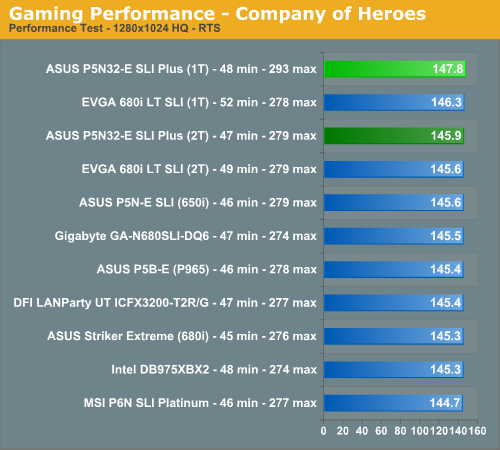
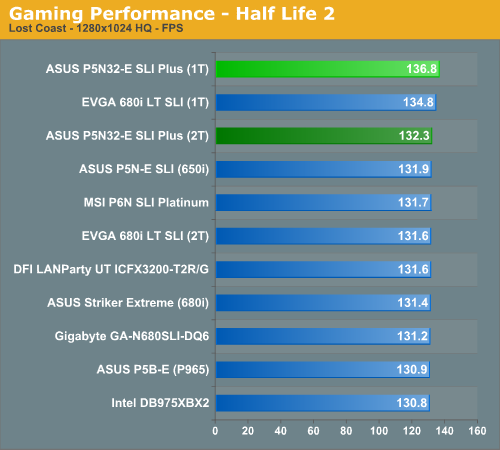
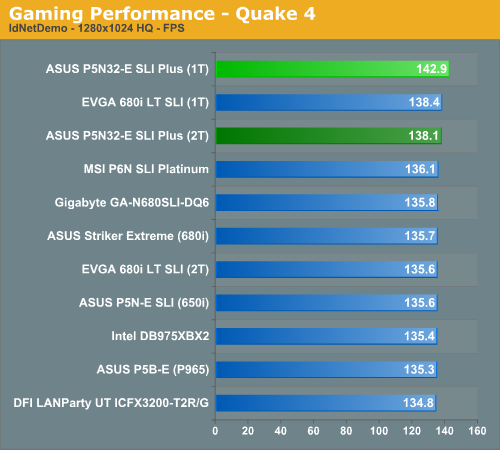
We still think it is basically a toss up as to which chipset you select for a gaming machine. All of the results are very close and during actual game play we could not tell any real differences between the boards. However, ASUS told us this board was optimized for game play and all indications from our test results agree with them. While the differences in overall scores are minimal to a degree, our subjective opinion after playing with the ASUS board for several weeks is that it's just a bit "snappier" than our other boards when it comes to game play. Our EVGA board also scored very well with 1T enabled but still could not keep pace with the ASUS board due to its extremely aggressive sub-timings.
We did not experience any issues during testing or during game play with the ASUS board at stock settings with our memory choice. We did encounter some issues with our budget memory modules due to the very tight memory sub-timings but once we relaxed tRC, tRFC, and tRRD timings the board was very stable. We generally play over a dozen different games for at least a couple of hours on each board to ensure there are no issues such as overheating, stuttering, or network issues when playing online with a various combination of components.
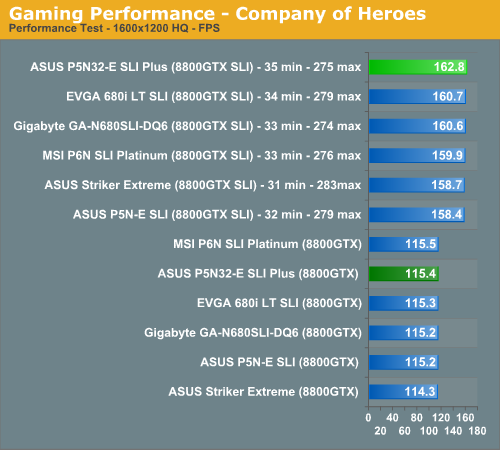
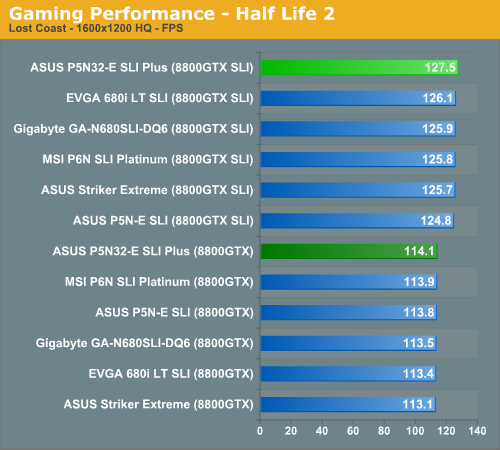
In our limited SLI testing, we once again find our ASUS P5N32-E SLI Plus taking top honors in our test results due to superior memory performance. We still have not seen any noticeable differences in 8800GTX SLI performance between the 680i, 650i hybrid, and 650i chipsets up to 1920x1200 resolutions in games. Any test result differences can be attributed to the performance of the board/BIOS itself and not the PCI Express design. It is only when you crank up the resolution to 2560x1600 or increase AA/AF settings that the dual x16 PCI Express capability on the 680i performs better than the dual x8 PCI Express setup on 650i setups. We will have additional game and resolution results in our roundup article.
As usual, gaming performance was tested with a variety of current games. We ran benchmarks with our standard 1280x1024 resolution without antialiasing enabled (and generally without anisotropic filtering, though that varies by game). Given the number of users that run 19" LCDs these days, 1280x1024 represents one of the most commonly used resolutions. We could certainly increase the amount of eye candy being displayed in most of the games, but as this is a motherboard benchmark we aren't particularly interested in maxing out the graphics cards in our tests.




We still think it is basically a toss up as to which chipset you select for a gaming machine. All of the results are very close and during actual game play we could not tell any real differences between the boards. However, ASUS told us this board was optimized for game play and all indications from our test results agree with them. While the differences in overall scores are minimal to a degree, our subjective opinion after playing with the ASUS board for several weeks is that it's just a bit "snappier" than our other boards when it comes to game play. Our EVGA board also scored very well with 1T enabled but still could not keep pace with the ASUS board due to its extremely aggressive sub-timings.
We did not experience any issues during testing or during game play with the ASUS board at stock settings with our memory choice. We did encounter some issues with our budget memory modules due to the very tight memory sub-timings but once we relaxed tRC, tRFC, and tRRD timings the board was very stable. We generally play over a dozen different games for at least a couple of hours on each board to ensure there are no issues such as overheating, stuttering, or network issues when playing online with a various combination of components.


In our limited SLI testing, we once again find our ASUS P5N32-E SLI Plus taking top honors in our test results due to superior memory performance. We still have not seen any noticeable differences in 8800GTX SLI performance between the 680i, 650i hybrid, and 650i chipsets up to 1920x1200 resolutions in games. Any test result differences can be attributed to the performance of the board/BIOS itself and not the PCI Express design. It is only when you crank up the resolution to 2560x1600 or increase AA/AF settings that the dual x16 PCI Express capability on the 680i performs better than the dual x8 PCI Express setup on 650i setups. We will have additional game and resolution results in our roundup article.










37 Comments
View All Comments
JarredWalton - Monday, April 2, 2007 - link
Sorry - just an errant typo correction. If you look at the image, you can see it's 1T. Gary had "TT" in there and I corrected that to 2T when it should have been 1T.yacoub - Monday, April 2, 2007 - link
oh awesome :)mostlyprudent - Monday, April 2, 2007 - link
I think it's time for a comprehensive article to pick the best boards for Intel CPUs (P965 vs. 680i vs. 650i vs. 680i LT vs. 975X vs. RD600, etc.). I know some of this has been done in pieces, but it would sure be nice to have it all in one article. Please :)Gary Key - Monday, April 2, 2007 - link
After I finally complete the opus known as uATX or "How to kill the reviewer", we will have a performance roundup that might even include a new spin of the P35. ;-)yacoub - Monday, April 2, 2007 - link
It'd be awesome to see a round-up in time for the April 22nd Intel price drop and 6320/6420 release.I want to know simply: "The Best 650 SLI and 680 SLI NVidia-based Boards For 6320/6420 OverClocking" and NOT with any of that ridiculously over-priced Dominator or Flex XLC RAM. Just test with realistic RAM that actual people would buy like Corsair XMS2 or OCZ Platinum series and similar. High-end RAM but not retarded over-priced stuff with gigantic cooling mechanisms. Test RAM that's around $250 (or less) for 2GB matched pairs.
That's what I'd like to see. An actual overclocker 650/680 board round-up for the 6320/6420 c2d chips with RAM people who are looking for the best bang-for-the-buck would actually buy.
People who spend around $200-250 for the motherboard, $200-250 for quality, low-latency RAM, and $200 for the CPU.
There's a lot of us and we'd love to know which board to buy and which RAM works best with it when oc'ing.
sWORDs - Tuesday, April 3, 2007 - link
The OCZ2N1066SR2GK only costs €208 here, that's SLI ready, 1066 MHz, 5-5-5-15, 2x 1GB.The OCZ2N900SR2GK only costs €192 here, that's SLI ready, 900 MHz, 4-4-3-15, 2x 1GB.
yacoub - Monday, April 2, 2007 - link
This image link on page4 is different than the actual image:http://images.anandtech.com/reviews/motherboards/a...">http://images.anandtech.com/reviews/mot...sus/p5n3...
http://images.anandtech.com/reviews/motherboards/a...">http://images.anandtech.com/reviews/mot...sus/p5n3...
(I think one of the sample images is duplicated.)
JarredWalton - Monday, April 2, 2007 - link
Did someone fix this? They are definitely different images for me, although only minor differences.Marlowe - Monday, April 2, 2007 - link
Very nice review - looks like a good board! After reading the article I have some questions:Isn't the 'Plus' moniker ment to mean some kind of functionality with Vista? I think I remember when some previous Asus board got a new revision and the got the Plus moniker, it also got a small PCB riser board attached below the IO area.. ReadyBoost or something? Does this board have that? It's not that copper square behind the LAN/USB connections? Or maby it's just a new name for their mid-range boards.
Isn't that a 6-phase power circuit in the pics? I know the Asus site claims 8-phase, but they also have a wrong power circuit pic. The site also says "With the highest speed up to 800MHz," about the memory speed and doesn't mention support for EPP at all, so that must be wrong as well according to your article?
In the expansion slot area you write "two PCI Express x1" but that's not so? Isn't the top slot for the "SupremeFX" audio riser board?
In the Dual Core OC page, the E6300 has 2MB L2 not 4MB :)
And a question: I have the Tuniq120 as well, and the fan is placed ~7 cm over the board and placed in an angle so I guess there aren't much airflow going to those heatpipe sinks. Did you have to use an additional fan over the cpu area while using the Tuniq120 heatsink and overclocking? So if overclocking you *have* to hang some fan with zip ties or something over that area? Thats a bit of a hassle isn't it :P
Anyways very nice performing board :D Looks physically totally identical to the Asus P5N32-E SLI tho :D But
sWORDs - Tuesday, April 3, 2007 - link
The E Plus is ment as an upgrade to the E, it has all solid caps just as the Striker.The E, E Plus and Striker all use the same PCB (just look under the white sticker) and all have a 8 phase power design.
All three have EPP and SLI Ready support up the 1200 (and the 1250 works as well).
The top one can only be used for the riser.
True.
The Northbridge does get very hot, however using the heatpipes should be enough to reach 450. Any busspeed above 400 isn't recommended anyway because of the reduction of timing from the strap selection.
True, they share the same PCB, this one has the same caps as the Striker.